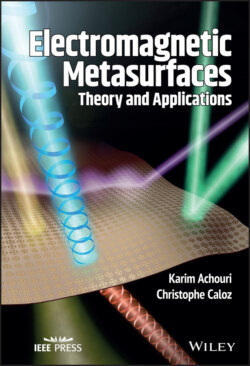Читать книгу Electromagnetic Metasurfaces - Christophe Caloz - Страница 13
2.1 Bianisotropic Constitutive Relations
ОглавлениеThe electromagnetic response of a linear medium may be expressed in the frequency domain, using the MKS system of units, as
(2.1a)
(2.1b)
where (C/) and (Wb/) are, respectively, the electric displacement vector and the magnetic flux density vector, which depend on the applied electric field vector (V/m) and on the magnetic field vector (A/m) as well as on the material polarizations via the electric polarization density vector (C/) and the magnetic polarization density vector (A/m). The constants F/m and H/m are the vacuum permittivity and permeability, respectively.
The polarization densities in (2.1) are typically expressed in terms of quantities which are either microscopic, the polarizabilities, or macroscopic, the susceptibilities. Although both the microscopic and macroscopic descriptions are applicable for modeling metasurfaces, we will mostly use the macroscopic model throughout the book, because it more conveniently describes metasurfaces as homogeneous media. For a bianisotropic metasurface, the polarization densities in (2.1) read
(2.2a)
(2.2b)
where m/s and are the speed of light in a vacuum and the vacuum impedance, respectively, and , , , and are the electric, magnetic, magnetic-to-electric, and electric-to-magnetic susceptibility tensors, respectively. Note that these susceptibilities are all unitless. Substituting (2.2) into (2.1) yields the bianisotropic constitutive relations
(2.3a)
(2.3b)
where is the unity dyadic tensor. Sometimes, these relations are also expressed in the more compact form
(2.4a)
(2.4b)
where (F/m), (H/m), (s/m), and (s/m) are the permittivity, permeability, magnetic-to-electric, and electric-to-magnetic tensors, respectively.
In basic optical and microwave engineering, the susceptibility tensors in (2.3) typically reduce to scalar quantities because most materials are isotropic. Moreover, the magnetic-to-electric and electric-to-magnetic terms are often ignored because the majority of materials do not induce such kind of magnetoelectric coupling. In contrast, metamaterial technology allows one to engineer artificial materials that exhibit very sophisticated electromagnetic responses involving all the 36 susceptibility components1 of these tensors.
In addition, the metamaterial susceptibilities may be functions of: (i) the position, , (ii) the time, , (iii) the frequency, (temporal dispersion), and (iv) the direction of wave propagation, (spatial dispersion), or a combination of these dependencies. This suggests a grand classification of metamaterials in terms of direct and Fourier-inverse space and time dependencies, as shown in Figure 2.1, where the 16 distinct types of dependencies correspond to a myriad of distinct bianisotropic media.
Practically, some of the 16 media types represented in Figure 2.1 are still challenging. For instance, time-varying () or spatially dispersive () metamaterials are more difficult to realize than spatially varying ones (), which only involve a spatial modulation in their geometry. Moreover, all the materials are de facto temporally dispersive,2 and particularly metamaterials, which strongly rely on resonant scattering particles to manipulate electromagnetic waves. Finally, some of these dependency combinations are also restricted by the uncertainty principle, as shown in [24]. Thus, metamaterial technology is often limited to a subset of the material types in Figure 2.1. Specifically, the most common types of metamaterials exhibit material parameters such as (e.g. quarter/half-wave plates) and (e.g. lenses and refractors) and, to a lesser extent, (e.g. angularly asymmetric absorbers) and (e.g. diffractionless refractors). It should be emphasized that this rich diversity of space–time variance and dispersion illustrated in Figure 2.1 is restricted to linear metamaterials. As we will see in Section 4.3, the introduction of nonlinearity further increases the number of degrees of freedom for controlling electromagnetic waves.
Throughout the book, we will adopt a particular naming convention to better describe the type of medium we will be dealing with. A medium with , , and will be referred to as a homoanisotropic medium, where “homo” indicates same excitation-to-response effects, i.e. electric-to-electric or magnetic-to-magnetic. A medium with , , and will be referred to as a heteroanisotropic medium, where “hetero” indicates different excitation-to-response effects, i.e. electric-to-magnetic or magnetic-to-electric. Finally, a medium with nonzero susceptibilities from all four tensors will be generally referred to as a bianisotropic medium.
Figure 2.1 Classification of (bianisotropic) metamaterials in terms of their space–time variance and dispersion. The I- and D-notations refer to the inverse and direct space/time domains.
